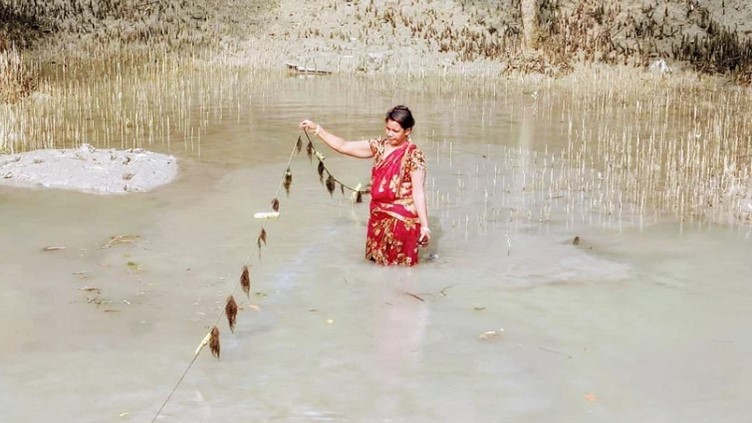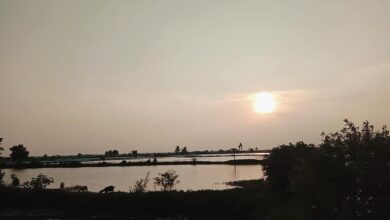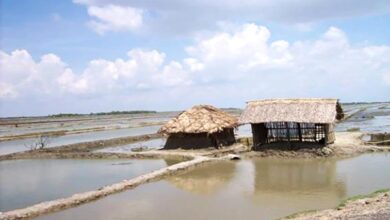
The Cox’s Bazar region is very popular for seaweed, it is also cultivated in the southernmost upazila of Khulna, in Koyra. Seaweed farming gains traction in Tepakhali village of Koyra Upazila. When the Bangladesh Agricultural Research Institute confirmed the feasibility of seaweed cultivation in this region and obtained positive results, mass-scale farming started.
There are 133 species of seaweed in Bangladesh, and eight of them are commercially significant. In addition to its tremendous medical and gastronomic value, seaweed has significant export potential as a seafood product, which may generate large foreign exchange. Moreover, seaweed is used in the bio-chemical, pharmaceutical, and cosmetic sectors.
Local residents row ropes with bamboo in the enclosure of saltwater fish gher at the bank of the Shakbaria river. They tied seaweed seeds to that rope and submerged it under brackish water. As the algae lack roots, seaweeds float on the water’s surface, thanks to their pneumatocysts. Once they find anything that will serve as a substrate, they attach themselves there. For the ropes, they are able to float in a certain area while remaining stationary. Basanti Munda, a local farmer said, “this algae grows by taking nutrients directly from the water. They have no roots, stems, leaves, flowers or fruits. The cost of cultivation is only the purchase of bamboo and rope.”
Similar bamboo tops float on the water at Ghulam Mustafa’s fish cultivating enclosure, located a short distance from Tepakhali in Koira Upazila. Under one foot of water, a 25-meter-long, robust rope is drawn tight with bamboo. On this rope, 15 cm long chunks of algae are hung. This is how the dreams of coir farmers are swinging under the salt water.
Farmer Golam Mustafa said, “Last year, the local exporters advised us to cultivate these algae. We are just putting them on the ropes as they suggested. These algae grow spontaneously without any care. They are eaten by ducks, fish and we heard people eat them too! Those who advised us to cultivate them said they will buy from us again.” Insecticides, fertilizer and fresh water are not required for seaweed production. This ensures that fishermen will always be able to make a living, even if they are unable to fish due to environmental or safety issues.

Farooq Hossain, Senior Scientific Officer of Bangladesh Agricultural Research Institute said that “It has been found that seaweed is tolerant to the salinity level of Koyra upazila. Koyra is more suitable for seaweed farming than Cox’s Bazar. So seaweed cultivation can be done easily here. Apart from this, success is achieved only by tying a rope with bamboo in the water and tying algae seeds to it, and submerging it without any maintenance.
Bangladesh Agricultural Research Institute chief scientific officer Harunor Rashid said, “seaweed is a delicious food that was unknown to many people in Koyra. We have trained 60 farmers in Koyra to produce potentially exportable and highly nutritious seaweed. Its seeds are collected from St. Martins have also been supplied to the farmers. Seaweed has a good market in the country and abroad. If we can capture the desired market, it is hoped that algae will revolutionize the economy of Bangladesh,” he added.
According to GM Insights, the worldwide market value of seaweed might approach to $85 billion by 2026. Although over 80% of the world’s seaweed production comes from Asia. By FAO stats from 2019, top 5 countries who are producing the most seaweeds are China, Indonesia, Korea, Philippines, Japan. Bangladesh seaweed production is estimated somewhere around 600 tons yearly.
Therefore, Bangladesh’s respective authorities should encourage the cultivation and use of seaweeds. Improving harvesting methods, creating artificial habitats and seeding appropriate coastal regions are necessary to boost the output. Research should be conducted to develop the technologies necessary for the production of various economically significant seed stocks and their enhancement. In addition, comprehensive studies must be carried out to identify ideal locations for seaweed cultivation on a wide scale.
Jaber Bin Abdul Bari
Dept. of Fisheries and Marine Science, NSTU




